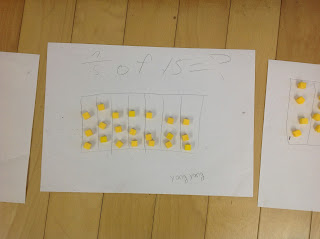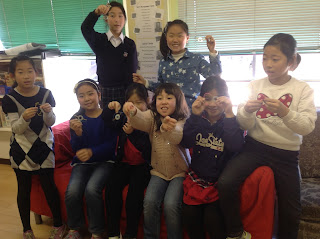Today, third graders and fourth graders joined forces to celebrate mathematics learning. They shared math games and math strategies with parents, students in other grades, and teachers. Mr. Hughes commented that the "students were fantastic this morning - lot's of engaging games for different areas of Mathematics... They did a great job sharing the different strategies used in the classrooms." We hope you agree!
At this time, the main focus of mathematical investigations in fourth grade continues to be parts and wholes, especially fractions. We began with lots of models, including shape models, line models and set models, such as the ones below:
Even students who are able to solve addition, subtraction and multiplication problems of fractions using algorithms can have difficulty demonstrating an understanding of the problem with a model. Trial and error is challenging, enlightening and fun.
We are also developing strategies to compare and order fractions. After that students will take a look at other ways of representing parts and wholes: decimals and percentages.
Thursday, February 23, 2017
Monday, February 20, 2017
Semester Two Learning Outcomes
Below you will find the Semester Two intended learning outcomes for all subject areas. Click on the links to view and download the documents. If you have any questions about these learning outcomes, please contact your child's homeroom teacher, our PYP Coordinator (Michael Hughes), or our Elementary Principal (Sandra Mulligan).
Sunday, February 12, 2017
How the World Works
Our current unit in How the World Works on Energy has been quite exciting. After becoming familiar with the different forms of energy that we experience in our daily lives, we took our thinking further by inquiring about how energy transforms.
Our lines of inquiry are:
● Different forms of energy ● How energy is used and transformed ● The Scientific process
We have learned that there are more to toys than just fun and games. Toys have energy and can create energy transformations!
Fourth graders built paper bangers, gas machines, flying plates, and paper windmills. As they played, they observed what form of energy each toy had and how that energy was transformed into a different form of energy.
After observing how energy was transformed in each toy, they begin to experiment with variables and tested out their own questions. One questions was "Which material will make the loudest bang?"
They found that in order to create a fair test it was important to keep certain variables the same and to change the variable they were testing. To find out which material made the loudest bang, ask your daughter about the results.
Thursday, February 2, 2017
Rights, Responsibilities, and Rules Transitions to Energy
This week fourth graders got started on the How the World Works unit, which focuses on Energy. However, on Wednesday, an opportunity to revisit Rights, Responsibilities and Rules came up and we took it.
Genevieve Bassett, a high school teacher at St. Mary's, visited. Ms. Bassett participated in the recent Women's March in Tokyo and shared her experience with us about the March and her thoughts about taking action in general.
During the Rights, Responsibilities, and Rules unit, children learned not to take rights for granted. Although the Convention on the Rights of the Child has been signed by most countries in the world, it is our responsibility to ensure that rules uphold rights for all. The fourth graders bombarded her with lots of excellent questions at the end of her presentation.
One activity that some fourth graders participated in to get started thinking about energy involved sorting energy related phrases by whether it seemed more true or more false.
In this way, various misconceptions or issues about energy came out, giving us an opportunity to debunk and/or rethink them. I captured a little. Please see for yourself:
Finally, fourth graders got started thinking about energy this week by creating "toys". Putting them together and messing around with them gave them the opportunity to contemplate forms of energy in everyday life. We will consolidate that knowledge in discussion and other activities by considering how energy moves (transfers and transformations). Hopefully, your child will be able to explain those terms to you in the coming days.
Genevieve Bassett, a high school teacher at St. Mary's, visited. Ms. Bassett participated in the recent Women's March in Tokyo and shared her experience with us about the March and her thoughts about taking action in general.
During the Rights, Responsibilities, and Rules unit, children learned not to take rights for granted. Although the Convention on the Rights of the Child has been signed by most countries in the world, it is our responsibility to ensure that rules uphold rights for all. The fourth graders bombarded her with lots of excellent questions at the end of her presentation.
One activity that some fourth graders participated in to get started thinking about energy involved sorting energy related phrases by whether it seemed more true or more false.
In this way, various misconceptions or issues about energy came out, giving us an opportunity to debunk and/or rethink them. I captured a little. Please see for yourself:
Finally, fourth graders got started thinking about energy this week by creating "toys". Putting them together and messing around with them gave them the opportunity to contemplate forms of energy in everyday life. We will consolidate that knowledge in discussion and other activities by considering how energy moves (transfers and transformations). Hopefully, your child will be able to explain those terms to you in the coming days.
Subscribe to:
Comments (Atom)


















